Krissy Moehl setting out on fastest-known-time efforts is not a new concept. She’s a previous women’s supported FKT holder on Washington state’s Wonderland Trail, and also a previous FKT holder for both the Grand Canyon’s R2R2R and the Zion Traverse. Last week, Krissy set a new women’s supported FKT on the Tahoe Rim Trail [TRT], which loops California’s Lake Tahoe in about 175 miles. Krissy’s new record of 47 hours, 29 minutes bests the previous record set last year by Amber Monforte at 49 hours, 17 minutes.

Krissy Moehl begins her FKT effort. Photo: Gary Gellin
iRunFar: Congratulations!
Krissy Moehl: Oh, thanks. It was so cool. You know, our team was awesome. The only thing I can take credit for is putting together an awesome team. The team totally executed. I’m such an organizer and planner. I had tons of spreadsheets and maps and clipboards and highlighters. I pawned it all off on them, and then they took it to another level.
iRunFar: The FKT concept is not new to you. How did your crew this time compare to past efforts? Because the difference I noticed was its size.
Moehl: It was big! This is the biggest thing I’ve ever done, too. John Muir Trail last summer would have been. That was actually a pretty big organizing effort to get that dialed in for Jenn [Shelton] and I. When I ended up not being able to finish it, I thought, Well, maybe my organizing efforts were what enabled Jenn to finally finish it. She would even say that organizing is not her strong suit.
iRunFar: Running is hers!
Moehl: She’s a great runner, that’s for sure, and story teller. I think she’s an amazing writer. Being out on the Appalachian Trail [AT] this year helped a lot, too, having seen Scott Jurek and what his systems were—taking some of the lessons I learned out there and applying them to this team.
iRunFar: What did you learn from watching Scott?
Moehl: On the AT, I thought it was really cool that the first time I told Scott to eat, he would eat. This is 40 days in and he’s still eating every half hour—putting a gel or a block or a bar in.
iRunFar: Amazing.
Moehl: I thought, Yeah, I can do that for two days. I can eat every half hour for two days. In terms of a team [on Scott’s effort], we were pretty sparse out there. We were all worked as a crew because we were doing 30 miles per day. He was doing 50, but we were doing 30. I remember a couple times people saying, “I’m so tired. I don’t know if I can go again.” “Gosh, but Scott’s doing it.” I was like, “Yeah, but it’s Scott’s goal. It’s not our goal.”
I wanted to make sure people knew on the TRT that just because I have them down as a pacer didn’t mean they had to go. I wanted them to take care of themselves. I had plenty of people, obviously, so there would be somebody who would be able to go.
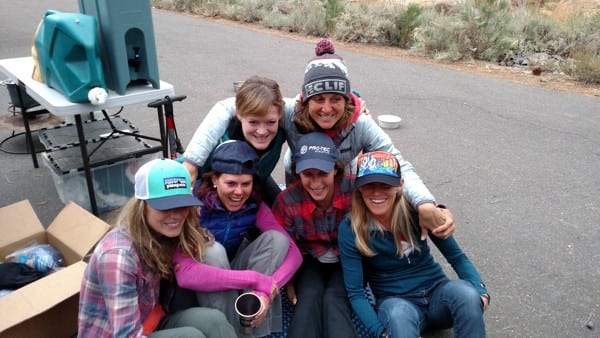
Part of Krissy’s crew. Photo: Gary Gellin
iRunFar: What made you decide on the TRT?
Moehl: I was at the Alpenglow Mountain Festival two years ago. Alpenglow is a little retailer in Tahoe. I got to run on a mile of the trail and fell in love with it. This thing is amazing. This summer, Jeff and I hiked it in seven days. I couldn’t shut up about it. “Oh, if I started here and finished here…” All the details were rolling in my head the whole time. Yeah, then the timing worked out this fall. I moved out of Boulder[, Colorado]. I’ve been living out of my car for the last two months. My parents have been letting me base out of their house, but I’ve been in Washington maybe a week. It all worked out to be here at this time of the year.
I thought it was really serendipitous when I was looking over some past FKTs. Kilian [Jornet] started on September 28. JB Benna started on September 28. I had an almost full moon that night.
iRunFar: All the stars aligned.
Moehl: Yeah. I was thinking about my first Wasatch 100 Mile, and I wrote an article for UltraRunning Magazine with the title, “When the stars align.” It was so cool how many years later to have another one of those.
iRunFar: When you did the trail in seven days earlier this summer, were you looking at it like, “Hmn, could I run faster on this trail?”
Moehl: Totally, yeah. I did not want to run it in June. We kind of trotted a little bit. We had pretty light packs, but we bivvied out, so we had some stuff with us. I didn’t want to run. I wanted to take it all in as a slower 25 miles per day—25 miles per day isn’t necessarily slower, but… Do you know The Emerald Mile? Have you read that book? Kevin Fedarko?
iRunFar: Yes.
Moehl: He makes the comparison because people give him grief for, “Why would you want to run through such a beautiful place so fast?” in the Grand Canyon, on the river. I won’t do it justice, but his statement of experiencing it in two different ways—he’s guided it in 18 days to three weeks multiple times. It’s different to go through it that fast. That’s what I kind of felt like. I wanted to have both experiences on this one.
iRunFar: I was going to ask you about that because trail runners and ultrarunners have come under fire in the last week or so. There was an op-ed in High Country News. The author thinks endurance runners in the Grand Canyon are “missing the point,” and they’re not having the right experience because they’re moving too fast. Because you did the TRT twice in two totally different styles but in a short period of time, how would you respond to that op-ed?
Moehl: I wish I could quote Kevin Fedarko’s book. He says it so eloquently and beautifully that they’re two totally different experiences. I remember being out there in June and looking across the lake and knowing that was two days away. The Desolation Wilderness is pretty easy to spot with that white granite up against the Sierra and know it would take a couple days to get there. This was like, the Desolation Wilderness was the first thing I did on this trip. I started in a different spot than we started the hike. To come back around and see the Desolation Wilderness and know, “I’m almost done.” It hadn’t even been two days yet. To look back over the lake and all those stories. Darcy [Piceu] ran 70 miles with me. People were running these crazy distances to help me.
It’s so different than taking it in day by day and seeing it all in the daylight versus passing through things in the night. I don’t think I could have done it having not done it slow because there’s so much that you kind of miss, but then to experience it differently is another gift. I don’t know if I’m answering this. Can I just call Kevin Fedarko?
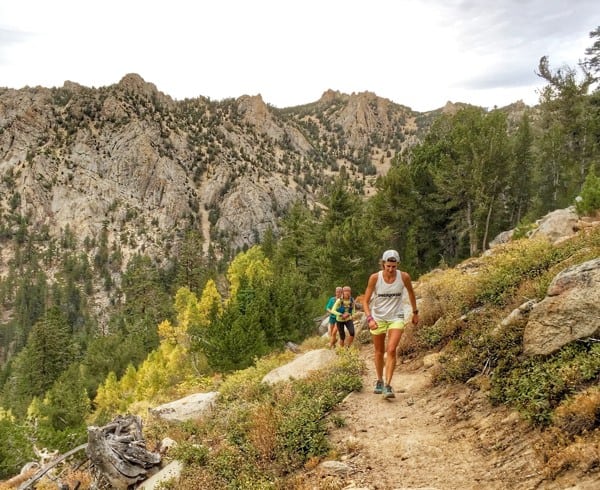
Krissy taking in the Tahoe Rim Trail. Photo: Gina Lucrezi
iRunFar: That was a great answer. Having watched you be a trail runner for quite some time now, it looks like your motivations are changing. I see you go exploring to new places, and you’ve done a couple of these more-than-a-day FKT efforts. What is the evolving motivation of spending more than the typical time of an ultramarathon out there?
Moehl: I don’t know if it has to do with time, more like location and place. Racing for 15 years and getting to go all over the world, I’ve come to realize recently, I’ve learned the mountains through trail running. Roughing it, for me, growing up with my parents, was like being in the motor home without plug-ins. The fact that I love living out of my car now and being up in the mountains and overnight—all that stuff has come through trail running and trail racing.
I feel like it’s an evolution of the skillset I’ve learned and applying it to different places. These places you couldn’t have a race on—the Wonderland Trail or the Zion Traverse or the Grand Canyon—but I have the skillset to move through those places thanks to trail running and the races that I’ve done. At this point, I don’t have the desire to do those multi-day things. Two days is good.
iRunFar: “I really want a hot shower and hot food after that.”
Moehl: [laughs]
iRunFar: Do you find yourself consciously choosing these adventures, or do they choose you?
Moehl: I think they choose me.
iRunFar: Like the Tahoe Rim Trail just spoke to you?
Moehl: Yes, and it really is a runner’s trail. It’s such a beautiful running trail. John Muir Trail is a really difficult… Mike [Wolfe] and Hal [Koerner] and Jenn and all those guys would say, it’s a tough, beat-you-up trail. Tahoe Rim Trail is a runner’s trail. The Desolation Wilderness is the toughest part, and it’s still not that bad. It’s not that technical. Yeah, it’s like the Western States Trail or something. There’s less than 30,000 feet of gain in 170 miles. People say it’s 165 to 175 miles.
iRunFar: It is kind of like a Western States 100 course, isn’t it?
Moehl: Yeah, it’s not net downhill, but otherwise it’s smooth, cruise-y trails.
iRunFar: How did your strategy come together? You’re a super organizer, so I know you probably had it all on paper.
Moehl: I did—spreadsheets.
iRunFar: “Spreadsheets, specifically Excel, thank you.”
Moehl: Yep. I’m such a dork. It was like the stars aligned for the last three months since I started to put this together. When we hiked the trail, we came down into Big Meadow, and we camped at Big Meadow and just thought it was such a good area and would be a really good base. Afterward we went through Desolation Wilderness, and I knew that would be the hardest section and I wanted to get that done first while my legs were still fresh. The location and everything seemed to make a lot of sense, and also getting through Desolation Wilderness in the daylight because it really is the prettiest section with the high, alpine lakes like Lake Aloha. You want to see those. You don’t want to blast through those at night. So for me, that made the most sense. You go over the highest points at the end. Mount Rose was at 108 miles and Freel Peak was way closer to the end at 150 miles or so. They’re all that grade that if you were fresh you could run, and it just goes on for a long time.
Then my crew, just in talking about it, people were like, “I’ll come. I’ll come.” Themkey part was I had four sponsors that stepped up and not only covered my own costs but my crew’s costs financially. I obviously didn’t make any money, but to be able to say, “Hey, I’ll buy your plane ticket,” that was such a gift. I just added up all my receipts last night and actually came in under budget, so I was pretty psyched about that. Clif Bar and Patagonia really stepped up, and then Flora and Pro-Tec picked up the rest of the bill.
It was crazy because I got really sick at the beginning of September. I had a stomach virus that put me on the couch at my parents’ house all week. I actually ran more mileage in the two days on the Tahoe Rim Trail than I did the whole month of September.
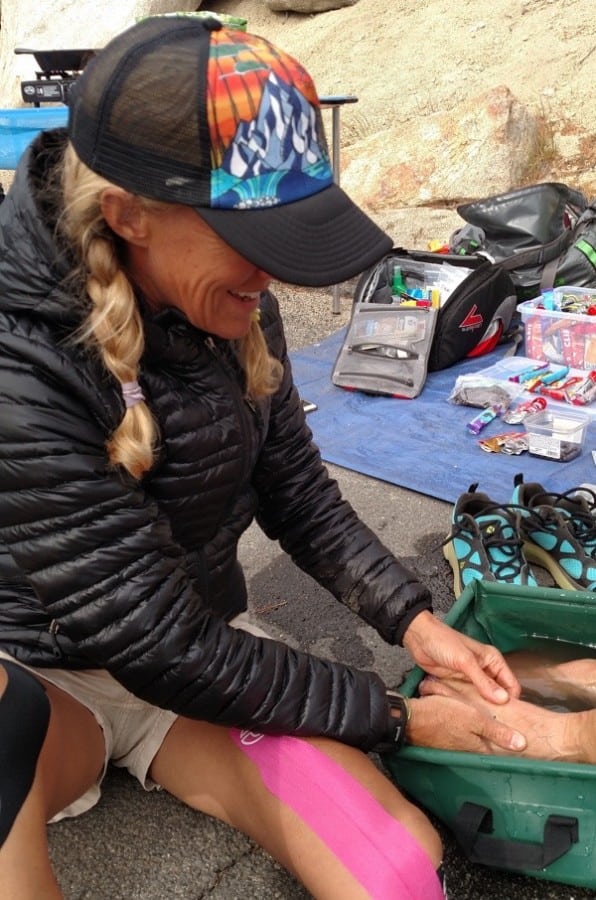
That’s what friends are for. Darcy Piceu administers foot care. Photo: Gary Gellin
iRunFar: You were rested.
Moehl: Right? As that was all happening, everything else was lining up—my stomach wasn’t—but everything else was lining up. Just the right amount of crew people lined up. Financial support came in. Products showed up. Everything I needed was happening. My parents were able to finagle their schedule so they could be there.
It was all pending on my belly. My stomach is my beast. I’ve always been known as the big eater. I can put food away when I’m out there. I kind of depend on that. I get after people for not eating when they think they can push through.
iRunFar: Did you use splits from last year—Jenny Capel’s or JB Benna’s splits? Did you make a spreadsheet of pace or did you kind of let that come more organically based on how you felt?
Moehl: I had two columns on the spreadsheet of four-mile-per-hour pace and three-mile-per-hour pace. Four-mile-per-hour pace would have been around 42, 43 hours. Three-mile-per-hour pace totaled near 55 hours. I knew I had to average somewhere in between. Then you have to figure in crew stops and bathroom stops. I slept in Tahoe City for 45 minutes. The four miles per hour was kind of my goal. If I could just keep that pace, that gave me a four- or five-hour buffer to break 48 hours. I wanted to be done in under two days. That was my big goal. It really came down to the last marathon which is what was crazy. I was looking at the time and knowing my pace, it wasn’t happening.
iRunFar: In other words, you were able to speed up and get back under 48-hour pace at the end?
Moehl: Yeah, we had to get moving quite a bit. I was close, but I had to really move. My pace had to change to get it done. I had Darcy and Gina [Lucrezi] with me at the time, and Monica [Ochs] joined for a good part of that. They didn’t let up. They were amazing. Fortunately, I was able to respond and stay with them.
iRunFar: Talk a little bit about the ups and downs of those two days. It must have been fairly miraculous to start in Big Meadow which is such a beautiful place and spend the day time in the Desolation Wilderness a really special part of the Sierra Nevada.
Moehl: It’s so cool that you know it. Yeah, just having the crew be so integral right off the bat. They kind of split into two teams at first, and one crew crewed me at Echo Lake right there at the store. The other crew hiked into Middle Velma Lake. So we got to see everybody in the first 50k, which was really nice.
Then I had it kind of organized that they would jump ahead so they could sleep and stuff, but they got so wrapped up in it that they all just crewed and everybody was together at every single spot. We were leaving Brockway and I was like, “Wait, everybody was there! You were supposed to go to sleep.” They said, “Don’t worry about it.”
iRunFar: “Yeah, but I need you two days from now. You guys need to take care of yourself!”
Moehl: Toward the end, after 100 miles, the altitude started to get to me. I’d get above 7,000 feet and I’d start to get wobbly and wavery and I couldn’t run downhills. Once I got below 7,000 feet, I could run again. It was just becoming aware of that. Once I figured that out, I was able to work through it better.
iRunFar: At first were you trying other things? “Is it electrolytes? Is it calories?”
Moehl: Yeah, or was I just done? Mentally, the low point was coming off of Mount Rose. It was probably the worst time and the best time that I had. I had six girls with me. Jenny Capel and Betsy Nye came out. Kathleen Egan and Monica were pacing me. Jen Benna came out. They were feeding me popsicles and Epic Bars and constantly getting me to drink and talking me through the whole thing. It was so funny because everyone else knew I was going to rally before I did, that I would come out of it.
iRunFar: Mount Rose is another of the most beautiful spots on the trail. You have a commanding view of basically your entire route. You were in excess of the 100-mile point at that point, and you still had a ways to go. What was it that hit you that caused that low point? Did you ever figure that out?
Moehl: I think it was being high for so long. You come up on that ridge to Relay Peak and you’re above 8,000, 9,000 feet for most of that, and then you go up over 10,000 feet at Relay, just barely. I think that’s what it was. Once I got down, I started to feel better. Then I noticed once I got above—on that next climb around Snow Valley Peak at 9,214 feet—I noticed I was feeling icky there. When we came off of there I was like, “Okay, here’s the problem—it’s altitude.”
iRunFar: Keeping the four-mile-per-hour pace average for two days is pretty stout. How did you break up the walking versus running? Was it entirely terrain-dependent? What about those areas where it’s runnable for quite some time? Did you take scheduled walking breaks?
Moehl: Mostly terrain-dependent. I just tried to run, mentally tried to run, every mile—just a little bit every mile. I can’t walk four miles per hour. I have to run little bits of that to keep that or maintain that pace. Then on those long climbs where you know you’re not going to run anything, you have to run the majority of the descent.
I wonder if I went out a little too hard. I asked the photographer that was out there, Fred Marmsater, he saw me. He ran a lot of Desolation Wilderness with me and then came out at later spots, too. I asked him, “Do you think I went out too fast?” He’s like, “No, you were really comfortable. It felt a little fast, but you were really comfortable.” I definitely slowed down compared to what I started at, but it wasn’t too bad. Then I finished stronger, I think. It felt worse in my head. They were like, “No, you’re at 3.8 miles per hour. You were at 4.2 miles per hour…”
iRunFar: Talk for a second about this: you’re looking at the terrain in front of you and you’re thinking that basically all of it could be runnable in a long run on any given day. But in your case you really had to reel things in. How did you keep that gauge set at the right spot? Did you look at it like, “If I run this now, can I run it in 100 miles?”
Moehl: Exactly that. I want to be able to run this later, so I have to be walking it now. I’d rather run it later. And I never wanted to be working really hard. If I was breathing too hard, I always tried to back off on that. I know I can hold four miles per hour the way that trail is without working too hard.

Krissy and Lake Tahoe. Photo: Gina Lucrezi
iRunFar: How did your crew stops go?
Moehl: I would say they were a lot like the latter miles of a 100 miler where you intend to get through really fast but you just don’t. It’s this little warm, comfortable bubble and you want to be with everybody. When you’re doing something that long, you kind of need that break to be able to keep pushing. I do anyway. That’s why I have all those people out there. I really enjoy them. They’re all really good people and I don’t want to blow through there. I get a lot of energy from seeing the treats they’d bring. At one point they brought breakfast burritos, and I was so excited. I want to make sure that I enjoy it. I definitely found myself saying, “Alright, I’ve got to get out of here.”
iRunFar: Did you ask your crew to set times? “Don’t let me stay more than 10 minutes.”
Moehl: No, the only thing we said was that we had at least 12 if not 15 spots at which I would see crew of some kind. I was like, “If I spend five minutes in each of those spots, that’s an hour-and-fifteen-minutes.” That was the only thing I said. I probably spent well more than five minutes in each spot. I know I did at Mount Rose. I should have had a time watch going at Mount Rose. I took a long time there.
iRunFar: It sounds like you may have needed that more than any other place.
Moehl: I did.
iRunFar: I understand there was an incident with bears.
Moehl: Oh, yeah. We were over 100 miles at that point, right around 120, and I knew the area. When I’d hiked it in June, we’d camped right through that area just after Spooner. You do the climb out of Spooner and then you’re back in the woods. It kind of zigzags in and out of the woods.
We came around a corner and Darcy is like, “Oh, look at the owls,” because we saw these green eyes turn around and look at us on a swivel. Then within not even a second on the tree next door, I saw this four-limbed creature pulling itself up in a tree, and it’s a baby bear cub. Initially we were like, “Oh, how cute, baby cubs!” Then all of a sudden we realize, “Oh, expletives, where’s the mom?”
Gina and Darcy started making all sorts of noise and backing off. When we were backing up, I saw one of the babies go down the tree. My thought was, Maybe mama called them down and they were going to take off. We backed off enough that we couldn’t see them. I moved forward again, wanting to see if they were still there. When I went back, both babies were up the same tree.
I thought I saw a mom, but my light was not so bright and I couldn’t be sure. I’d been hallucinating for awhile, so I knew I could be making it up. So Darcy ended up calling a couple of our crew people, and Fred talked us into walking around the bears. I guess technically I was off the TRT at that point because we went up on the burm and paralleled the trail for a good 300 or 500 meters maybe. We kept the trail in sight and kept a mark on where the bears were and then eventually got back down to the trail. Then Darcy blew her whistle for the next hour.

Krissy is paced by Darcy Piceu and Monica Ochs. Photo: Gina Lucrezi
iRunFar: “Attention, anything, we are coming!”
Moehl: Yeah. We took my trekking poles and were banging those together. Gina was singing songs. It definitely gave us a boost of adrenaline. We might have been stopped there for, I don’t know, it could have been 20 minutes, it could have been 45, and then moving through the hillside was slow compared to the trail. I’m not sure how long that whole incident took us, but I know we charged afterward. We got after it.
iRunFar: Talk about how it finished for you. You had your low point on Mount Rose, and then you rallied. You said you put things back together and sped up over the last marathon to get back under 48-hour pace—and to not just get under it, but to get way under it.
Moehl: That probably happened in the last four miles. I bet I ran six- or seven-minute miles in the last four miles. We were hauling.
It took a little bit to come back around after Mount Rose. The cool thing was JB Benna was there at Mount Rose, and he talked me through what I had left. That was a mental positive. There you’re at the point where you can finally think through the rest of it. When you have 170 miles ahead of you, you can’t think through all of it. When you have 40 or 50 miles to go, you can think through that.
After the bear incident and down to Kingsbury Grade, everybody was talking and telling stories and I was like, “I’ve got to go. I’ve got to keep going. I’m really worried about pace at this point.” I left and the pacers were right there. I did the math for them, and I think everybody got it because we all got quiet. It became everybody’s mission to get to the end. They kept saying, “Oh, you’ve got the record. You’ve got the record.” “I want 48 hours,” I told them. It was an arbitrary goal but I wanted to get in under 48 hours if I could. I felt the group latch onto my goal, and we just all kept moving. It was really cool because it wasn’t mine anymore.
Darcy and Gina were running the last miles with me, and it became theirs as well. Darcy’d go ahead–and she was playing music on her phone for us–and she’d scout out the trail. Gina hung with me and kept me eating.
With four miles to go, we just opened up. You just kind of have this feeling of, Well, it’s all downhill. It’s going to hurt, so I might as well get it done. It’s kind of surprising, I definitely have hurt worse after shorter races. I’m dealing with respiratory issues right now and sleep, but I’m not sore. It’s really weird.
iRunFar: How did that compare to the John Muir Trail, or do you think you’re acclimating to doing these longer things?
Moehl: I think they’re totally different experiences. John Muir Trail—I had giardia on the trail. I was so sick that I depleted my body so much out there. I think this one I was really able to fuel really well and keep stuff in. They’re kind of different deals. That one, I did 130 miles, but I did a lot of it on no nutrition.
iRunFar: Are you completely sated? Do you feel you got out of it what you put into it?
Moehl: Totally. It went better than I imagined. No regrets. Believe me, I imagined all of it.
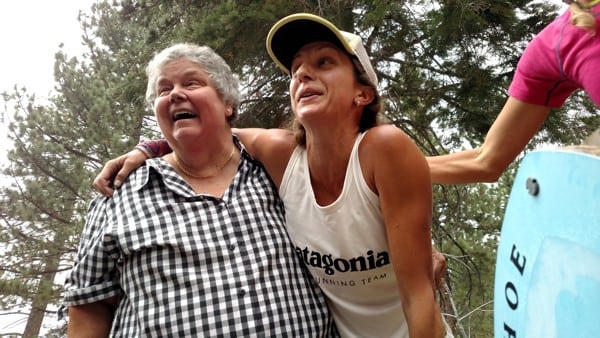
Krissy and her mom at the successful conclusion of her effort. Photo: Gary Gellin
iRunFar: You’ve accomplished so much in your very long trail running career. Each time you do these things, you prove that your potential is really unknown. What does a woman like you think after you finish something like this?
Moehl: I’m still trying to absorb it all, to understand what we did. I’m not looking at it in the way that you just described. I feel like it’s more just this one experience. I’m just so ecstatic with how it was such a team effort. I went into it thinking that way. I knew I couldn’t do this on my own. I needed this strong team. I’m just reveling in how well they worked together. They more than rose to the occasion.
Just as this one went amazing, the next one could be completely humbling. That’s what’s so cool about our sport. If you ever think you have it figured out, watch out. You’re just going to get it. Something is going to come and whack you upside the head. I’ve definitely had those moments, “Oh, I’ve got this.” Whoa, was I wrong. I think that’s probably the greatest lesson of the sport and why I love it and why I keep coming back and why I try different distances and why I try the same distances and try 100 milers again—I don’t have it figured out. My body is constantly changing. I’m definitely not as fast now—I’m almost 38, goodness. What it is to run these distances now versus when I started in my early twenties—I started when I was 22—it’s a lot different.
iRunFar: You answered my question, I think. Our sport still very much keeps you on your toes. You face things with, “Hey, there are no guarantees when we do things we’re not sure we can do, but we’re trying them anyway.”
Moehl: I think once that goes away for me, once that intrigue isn’t there, then that’s when it’s time to be done. I’m glad it’s still there, it’s just evolving.
iRunFar: Thanks for inspiring a lot of people.
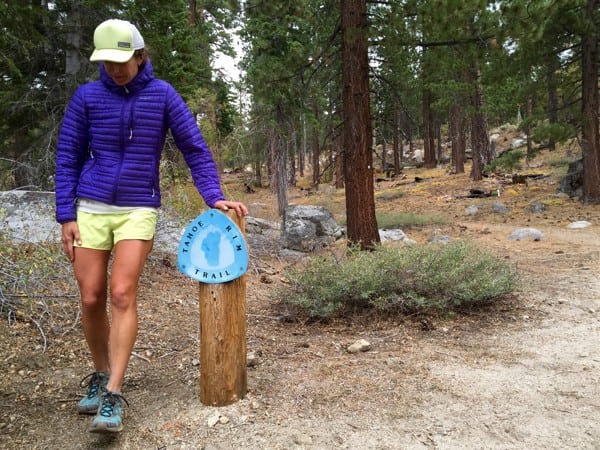
Krissy letting her new women’s supported FKT on the Tahoe Rim Trail sink in. Photo: Gina Lucrezi
